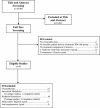The role of emerging and investigational therapies for metastatic brain tumors: a systematic review and evidence-based clinical practice guideline of selected topics
- PMID: 19957013
- PMCID: PMC2808529
- DOI: 10.1007/s11060-009-0058-3
The role of emerging and investigational therapies for metastatic brain tumors: a systematic review and evidence-based clinical practice guideline of selected topics
Abstract
Question: What evidence is available regarding the emerging and investigational therapies for the treatment of metastatic brain tumors?
Target population: These recommendations apply to adults with brain metastases.
Recommendations: New radiation sensitizers Level 2 A subgroup analysis of a large prospective randomized controlled trial (RCT) suggested a prolongation of time to neurological progression with the early use of motexafin-gadolinium (MGd). Nonetheless this was not borne out in the overall study population and therefore an unequivocal recommendation to use the currently available radiation sensitizers, motexafin-gadolinium and efaproxiral (RSR 13) cannot be provided. Interstitial modalities There is no evidence to support the routine use of new or existing interstitial radiation, interstitial chemotherapy and or other interstitial modalities outside of approved clinical trials. New chemotherapeutic agents Level 2 Treatment of melanoma brain metastases with whole brain radiation therapy and temozolomide is reasonable based on one class II study. Level 3 Depending on individual circumstances there may be patients who benefit from the use of temozolomide or fotemustine in the therapy of their brain metastases. Molecular targeted agents Level 3 The use of epidermal growth factor receptor inhibitors may be of use in the management of brain metastases from non-small cell lung carcinoma.
Figures
References
-
- Centre for Evidence-Based Physiotherapy (2009) Physiotherapy evidence database (PEDro). http://www.pedro.org.au/. Accessed Jan 2009
-
- Maher CG, Sherrington C, Herbert RD, Moseley AM, Elkins M. Reliability of the PEDro scale for rating quality of randomized controlled trials. Phys Ther. 2003;83(8):713–721. - PubMed
Publication types
MeSH terms
Substances
LinkOut - more resources
Full Text Sources
Medical
Research Materials


